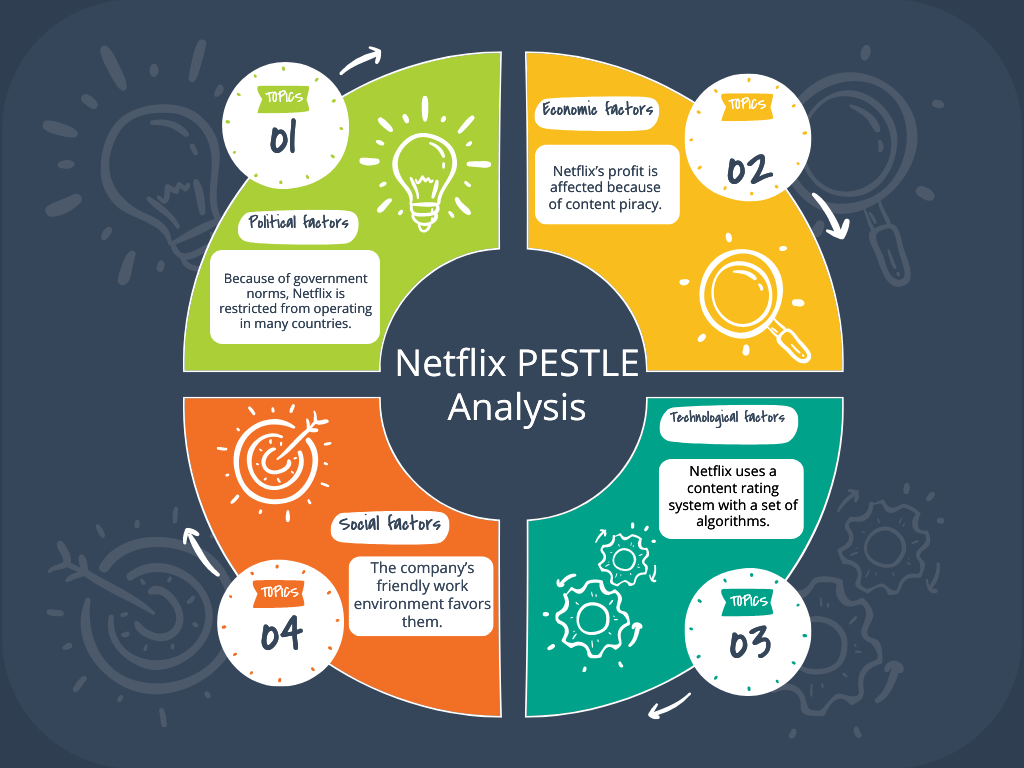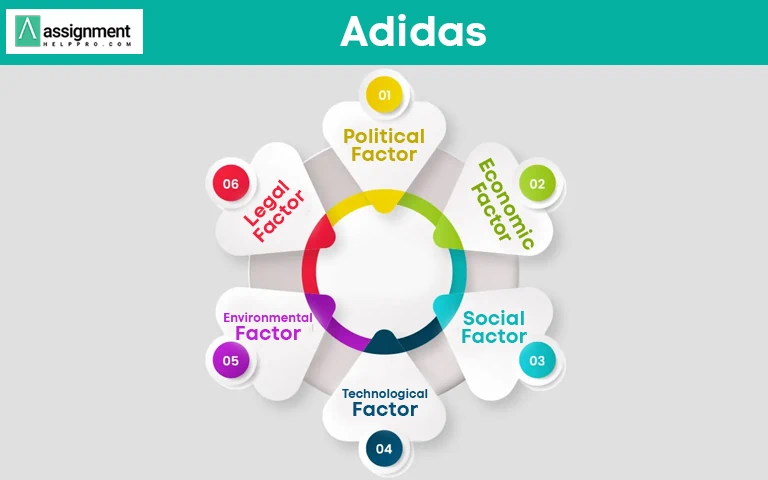Do you want to write a PESTLE analysis case study assignment? Are you confused about how to write a PESTLE Analysis for large corporations? Cool! In this blog post, for your better understanding, we have provided a PESTLE Analysis Example of the top five multinational companies. Go through that real-time analysis because it would be helpful for you in writing your assignments.
Before, we look at the examples; first let us see what PESTLE analysis means.
What is PESTLE Analysis?
PESTLE Analysis, also known as PEST Analysis, is a crucial marketing concept that examines the external key factors that have an impact on an organization. These factors include political, economic, social, technological, legal, and environmental factors. PESTLE Analysis is typically performed by businesses to monitor their operational environment or to prepare for the launch of a new product, service, or project.

A more comprehensive version of the SWOT analysis is the PESTLE analysis. Especially, by utilizing the PESTLE analysis methodology, entrepreneurs and business organizations more frequently determine the future scope of action, develop measures for strategic management, and also make appropriate decisions for their company.
PESTLE Analysis Example
Here, we have presented a PESTLE analysis case study of the top five businesses to assist you in comprehending the method. If you are required to complete a marketing assignment, you can also use the PESTLE analysis example for businesses that are listed in this post to receive a high grade.

The top 5 companies that are covered in this blog post are
- Amazon
- Netflix
- Starbucks
- Uber
- Adidas
Amazon PESTLE Analysis Example
Amazon is an American multinational company that focuses on e-commerce, digital streaming, cloud computing, and artificial intelligence. Despite having a stable place in the market, this technology company deals with many competitors in the market.
With the below-mentioned PESTLE analysis example of Amazon, let us identify the drawbacks of the company and also study the macro-environment factors that affect the company’s overall performance.
Political factors
- The cybersecurity of the government and the smooth e-commerce operation favor Amazon’s business.
- Amazon has detailed knowledge of government intervention and the scope of its business growth in the industry.
- The company’s online retail business has gained popularity because of governmental encouragement. But still, Amazon’s growth is at risk in the retail field due to tough competition from other big brands that are into online retail.
Economic factors
- In Asian countries, tax regulation is the only constant challenge Amazon faces frequently.
- In developing countries, the economic stability of Amazon has growth opportunities.
- The offers announced by Amazon attract consumers even when they don’t search for anything expensive.
Social factors
- In order to replace employees, Amazon depends more on technology. But as a result, it may lead to a decrease in job opportunities and thus can be a social threat to the company.
- The growth in online shopping leads to an increase in consumerism. One of the major reasons for the popularity of this brand is the easy availability of all products at the doorstep delivery for people of all age groups.
Technological factors
- Amazon uses creative and innovative ways to reach its customers. Still, they are exploring new ways of shipping to deliver the packages.
- The website and mobile applications make it easier for users to access the services of Amazon.
- The company has introduced a live chat option for easy accessibility. So, to ensure a better customer experience and for technological advancement, the company has planned to hire more people.
Legal factors
- When expanding its services worldwide, Amazon works as per the rules and regulations of all countries by focusing on cybersecurity and the safety of consumers.
- The company’s efforts on environmental protection regulations have strengthened its brand image. Besides that, the company also faces challenges from its competitors because of the changes in its export and import policies.
Environment factors
- Amazon has a high level of interest in environmental programs.
- The company’s interest in the promotion of business sustainability, waste management strategies, and the low-carbon lifestyle enhances its growth opportunities.
This PESTLE analysis of Amazon shows the authority of the brand in the industry. By concentrating on all the highlighted external factors that affect the business, the brand can still maintain to be in the top place in the online retail market.
Netflix PESTLE Analysis Example
Netflix is a popular over-the-top (OTT) content platform that has its headquarters in Las Gatos, United States. The streaming platform is offering its service in many countries across the globe. In recent times, people rely more on the OTT platform like Netflix for entertainment and binge-watch TV shows, movies, and web series during the weekends.

Here, let us explore the factors that affect the performance of Netflix through a PESTLE analysis example.
Political factors
- Censorship is one of the major issues for Netflix. Mainly because of its content, the Netflix streaming platform is prohibited in some biggest economies countries like China.
- Because of government norms, Netflix is restricted from operating in many countries.
- Netflix faces a considerable loss because in some countries, due to government rules and policies, the entire content of Netflix will not be available to the viewers.
- In the digital era, a large set of audiences moved from traditional TV to OTT like Netflix. So, in a few countries, the telecom giants have increased the price of the internet causing a threat to the business model of Netflix’s streaming service.
- In some countries, the company is taxed similarly to traditional media.
Economic factors
- Netflix’s economy is affected due to the fluctuation in the exchange rate when buying other production companies’ content. But it still manages to earn profit from its original content like movies, web series, and TV shows.
- A hike in the subscription price is one of the serious concerns raised by loyal customers of Netflix. The viewers will be satisfied only if the streaming platform offers high-quality content that is worth the money.
- As multiple streaming platforms have cropped up, Netflix is facing increased competition with its rivals because of the high-quality content that is being released by the other streaming service providers.
- Netflix’s profit is affected because of content piracy.
Social factors
- The company’s friendly work environment favors them.
- Netflix CEO’s generosity and kind nature have attracted a lot of people because they contribute 2% of their annual income to black support and also extend their support to students from low-income families.
- Flexibility is Netflix’s major benefit. The company always sails with the latest trends by encouraging users to view the live streaming on mobile.
Technological factors
- The user can watch a high-quality video on Netflix by spending minimal data.
- Netflix uses a content rating system with a set of algorithms.
- For language translation, Netflix uses Hermes, the automatic translating software.
Legal factors
- The company has a conflict with its customers because of the sudden increase in subscription prices. Some dissatisfied customers have also taken legal action against the company regarding it.
- Netflix regularly faces issues with a few customers because of copyright claims. Instead of blocking other country users, Netflix should find a suitable strategy to resolve the issue.
Environment factors
- Netflix has recently joined hands with the EPA and expressed its willingness to shift to renewable energy.
- For a sustainable future, it reduces the use of paper in the office.
- As it operates online, the business doesn’t impact more on the environment. But the electricity consumption is heavy.
Netflix is operating in nearly 190 countries with more than 195 million customers. The remote macro-environment factors create more impact on the company. By using this PESTLE analysis of Netflix, the company’s scope of growth in the potential market can be identified. By clearing all the shortcomings caused by external factors, Netflix can generate more profitability by attracting a lot of viewers.
Starbucks PESTLE Analysis Example
Starbucks is one of the biggest multinational chains that serve the coffee industry. The company has its headquarters in Seattle, Washington, and it operates its business in various countries of the world. When it comes to coffee culture in the world, Starbucks represents itself on behalf of the USA. However, the company also suffers from some external factors.
Discussed below is the PESTLE analysis example of Starbucks.
Political factors
- During the global expansion of the company, as per the recent trend of regional integration with external factors, many countries had bureaucratic red tape that made the business expansion of the company more difficult.
- As the corporation tax of the US coffee chain decreased by 60% during the Brexit event, the growth of the company was affected.
Economic factors
- The profit of Starbucks diminished because of the recession of the present global economy, and hence the customers have been convinced to consume cheaper products.
- The profitability of the company also faces stress due to a rise in the operational cost along with the labor cost.
- Other economic factors that affect the company are taxation level, currency exchange rate in the local market, and the economic environment of different local markets.
Social factors
- One of the biggest challenges in the socio-culture of the company is that the authorities sacrifice the company’s product quality when offering cheaper products to the consumers.
- Because of the ‘green’ and ‘ethical chic’ aspects, the environmental and social costs also fret the brand.
- When socio-culture is considered, circumstances like a change in lifestyle, change in work pattern, customer preferences, change in values, and change in family pattern also create an impact on the brand.
Technological factors
- Starbucks provides technology-based services in partnership with Apple. Especially, to attract customers through digital apps, the company offers discount coupons for the customers who operate the Starbucks apps using Apple and mobile phones.
- As internet services are important to customers, Starbucks provides Wi-Fi facilities to its customers in their outlets. It is a value-added service to the brand.
- For easy payment of bills through digital mode, the company has enabled Mobile Payment.
- In order to provide top-quality coffee to consumers, the company is focused on the implementation of agriculture, biotechnology, and other innovative technologies.
Legal factors
- The company is required to follow the laws and regulations of its home country as well as in the countries where it operates its business and purchases raw materials.
- Regarding the consumption of caffeine products offered by Starbucks, the health authorities also have policies and regulations.
- The company should adhere to the guidelines of the health authority with respect to maintenance.
- Other legal factors that Starbucks concentrates on are the trade regulations of their operational countries and the regulations for the licensing of their appropriate industry.
Environment factors
- The environmental disaster that arises during coffee harvesting is considered to be one of the serious environmental threats that may affect the company.
- Global warming is another different kind of environmental issue that impacts the brand at the global level.
- Starbucks can handle all the environmental issues and their impacts by following the environmental guidelines.
At the global level, the American Multinational Coffee chain Starbucks is well-known for its high-quality products. The brand has a unique set of customers, and it may also have an effect on the buyers that belong to both the lower and middle tiers of society. Starbucks can continue to be a leading brand if it concentrates more on the external factors that affect the business.
Uber PESTLE Analysis Example
Uber is a fast-growing taxi service provider offering its taxi services in the majority of countries in the world. It has earned many valuable customers because of its easy accessibility and the taxi-sharing facility. In recent years, the company has grown exponentially in many countries and also at the same time has earned outrage from its customers.
Now, let us have a look at the PESTLE analysis example of Uber.
Political factors
- Uber has been a part of many controversies because they have not made clear regulations.
- An ambiguity exists among the users regarding the insurance policy. More specifically, when an accident occurs during the ride of a customer, the company is not in the position to provide a valid answer on who is accountable, the driver or the company.
- As Uber is not following domestic laws, many Asian countries are planning to ban the company.
- In some countries, the brand is under heavy scrutiny by government officials.
Economic factors
- The company works in the sharing of physical and intellectual resources.
- Customers find it easy to avail of the taxi service Uber through apps. When compared to other private taxi services, Uber is cheaper, and it takes people to their desired locations.
- Since its establishment, the company has been growing rapidly beyond the imagination of economic experts. As Uber Taxi faces more competition, it results in the ban of their services in some countries.
- When compared to other leading taxi operators, Uber has faced most of the rage.
- In certain countries, many people reach out to Uber for new job opportunities. Actually, it was not evident whether Uber provides employment or takes away people’s employment opportunities.
- Uber has a name and fame among their customers and that is the major reason why they always focus on giving the best service.
Social Factors
- The mobile application of Uber is easy to use and accessible.
- The users can easily connect with the drivers by just giving their pick-up and destination location.
- As Uber offers premium services at a cheaper rate, customers across the globe are satisfied with the company.
Technological factors
- Uber has invested a lot in doing research and updating its technology to get indirect and direct benefits from it.
- The company wisely uses social media and electronic media for promotion.
- The application Uber is technically advanced, and with the Uber app, users can estimate the trip charge, weather, and traffic conditions.
- The Uber app is one of the customer-friendly apps with which customers can pay for the ride digitally through cash methods.
Legal factors
- As discussed above, Uber is currently facing many legal problems because of unpredicted reasons.
- The company should be alert to adapting labor laws, domestic laws in the field of technology, and employee safety rules.
Environmental factors
- There is no study conducted on the environmental impact created by Uber.
- There is speculation that Uber plays a negative role in traffic and fuel consumption.
- Also, there is an active argument that Uber is discouraging the use of public transportation among people and is causing traffic congestion.
In general, several controversies intervened and stopped the business growth of Uber. But, in order to survive longer on the field, Uber has to resolve all the issues in various countries and update their service as per the modern-day needs of the users.
Adidas PESTLE Analysis Example
Adidas is one of the popular multinational companies which supplies sports apparel and shoes. The company got its name after its founder, Adolf Hassler. Adidas is a German-based company that is currently a leader in the sports apparel market. The company is surviving in the industry by tackling all the challenges.

To understand more about the performance of the company and the factors affecting it, let us have a quick glance at the PESTLE analysis example of Adidas.
Political factors
- Adidas is one of the few companies that have faced many risks and civil turmoil. But it moves forward even after the huge political changes.
- The taxation system in the operational countries affects the company.
- Other political factors that affect the company’s work and the delivery of products are war, terrorism, national movements, etc.
Economic factors
- The progression rate and the company’s advancement are affected due to the fluctuations in the market and the instability in the global market.
- Till 2005, the company has faced many failures and difficulties in their economy
- The economic elements that have ruined the profit generation of Adidas are taxation, unemployment, inflation, and per capita income.
Social factors
- As the potential customers of Adidas are athletic and health-conscious people, such factors create a great impact on purchase preferences.
- The company is still not able to survive in Islamic countries. Hence, they should frame a strategy suitable to the Islamic culture and promote all of its products including shoes and other accessories.
- The biggest plus of Adidas is that it manufactures products and sports apparel as per the current trends disregarding religion, age, and sex barriers. So, all types of customers in society use their products.
Technological factors
- To climb up the ladder of success, companies like Adidas should adopt the latest and modern technology.
- Adidas has customers from all over the world because of its online marketing strategy.
- The company always stays a step ahead of its competitors because it invests more in research and development to create a unique identity for its brand in the market.
Legal factors
- Adidas retains the trust of its customers at the global level because of its high reputation and the brand value it possesses.
- Since Adidas is operating in various countries, the company’s management should be aware of restrictions, taxation methodologies, and domestic laws in each country.
Environment factors
- The company has claimed that it follows an industrial process that is harmless to nature and ecology.
- Adidas never produces any products that are restricted.
- The company uses modern technologies to check the emission of organic and volatile compounds that are harmful to the ecology.
- The company’s attitude towards environmental protection has helped it to enhance its brand image.
From this PESTLE analysis, it is evident that Adidas has a great reputation in the international market. But to move forward and cross more milestones, the company should set a high aim and explore new things in their territory.
Conclusion
Finally, we have reached the end of the blog post. Hopefully, by now, you will have gained a better understanding of how to prepare a PESTLE analysis for a company. In case, you are asked to write a marketing assignment on PESTLE analysis, follow the details as specified above. However, if you find it difficult to do a PESTLE analysis assignment, then reach out to us immediately.
1. Explain briefly about PESTLE analysis.
PESTLE analysis is a framework to analyze the macro-economical factors that can influence an organization’s performance. 6 key factors (Political, Economic, Sociological, Technological, Legal, and Environmental) are analyzed here, and based on this, strategies are made.
2. What is a PESTLE analysis example?
Analysis of labor cost of a particular area, economic trends, international exchange rates, and government policies are some examples of a PEST analysis.
3. Why PESTEL analysis is important?
With the help of PEST analysis, one can figure out the potential threats that can come from external sources. It helps the management to strategize the economic, marketing, and sales strategies in a better way.
4. What are the 6 PESTEL factors?
The 6 factors of PESTEL are Political, Economic, Sociological, Technological, Legal, and Environmental.



